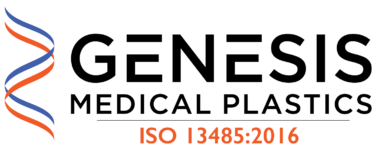Injection molding of medical plastics has become the primary manufacturing method for an ever-expanding array of devices and components. The process involves melting a medical plastic or polymer under tightly controlled conditions of pressure and temperature, then injecting the melt into a mold where it cools and solidifies to form the desired part.
The technologies behind the process and the tooling have advanced significantly, and the range of part configurations that can be injection molded is diverse. From electrical housings with thick wall sections to thin, intricate implantable devices, the molding process can turn out high quantities of medical products consistently to specification. It is also a contained, clean process that lends itself to the rigorous quality protocol required for manufacturing implantable medical devices.
What Types of Devices and Components are Typically Injection Molded?
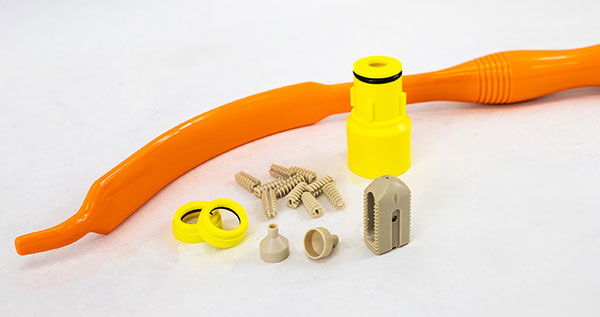
The advantages of flexibility, versatility, repeatability, quality management attributes and economics has made injection molding the mainstream process for manufacturing a variety of medical devices and components, including:
- Suture anchors used in sports medicine and arthroscopic surgeries
- Orthopedic trauma fixation bone plates and screws
- Endoscope housing components
- Implantable device housings and leads for pacemakers and defibrillators
- Implantable dental components such as abutments
- Single-use diagnostic, surgical, and therapeutic instruments and instrument handles
The Benefits of Injection Molding as a Medical Device Manufacturing Process
Injection molding of medical plastics is well-recognized for benefits that are particularly apparent compared to production methods for metals:
- Consistent, repeatable quality and high volume scalability: Today’s injection molding machines and tooling technology turn out multiple parts per cycle over long production runs, and do so quickly, consistently and efficiently. As quantity requirements grow, device manufacturers can scale up by investing in new tooling which their custom medical plastic processor can apply to their capacity. Multi-cavity tooling is also an option that can turn out more parts per injection cycle.
Once process conditions are defined for a medical plastic and mold design, the process itself is highly repeatable for consistent quality over the device’s or component’s life cycle. - Cost and time efficiency: Tool design and building is typically the single largest capital investment in the development of a medical device. It also requires a significant amount of time to transition from design table to the proven, final production mold. Once in place, injection molding is highly efficient on per-part basis relative to manufacturing cost and the speed at which parts are produced.
-
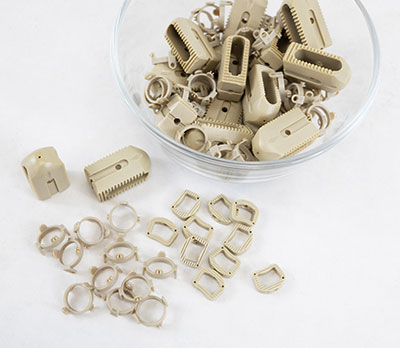
Devices molded from implantable PEEK plastic demonstrate the precision the process affords. Finish-machining can add more complex details if needed. Adaptability to simple and complex designs: State-of-the-art injection molding machines and tooling can yield benefits for a wide range of part configurations. Simple designs typically require relatively low cost tooling. Complex parts with intricate features can also be produced efficiently with the correct tool design and tool building expertise.
Full-service medical plastics processors with both injection molding and machining equipment can also be beneficial in producing more complex applications in medical thermoplastics. The combination of production capabilities allows finish-machining of extremely complex features into molded parts that may not be attainable by molding alone.
In addition, features such as insert molding can be integrated into the process for further customization or to facilitate assembly of multiple components.
Injection Molding Tooling: A Major Capital Investment
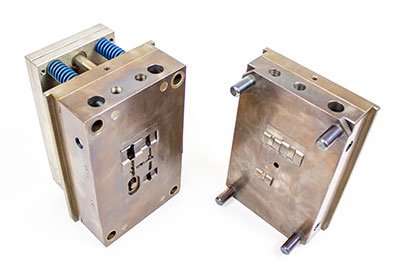
Efficiency, consistency, repeatable quality, and high volume requirements are the main drivers for injection molding as a manufacturing method for medical devices and other healthcare products made from thermoplastics. The projected quantity requirement for a device is usually the factor that justifies the complexity and cost of production tooling, usually the most significant capital investment in an individual medical device project.
Typical Injection Molding Process Steps
Three basic steps occur in the injection molding process:
- Drying: Prior to a production run, a pelletized medical plastic will be transferred from shipping containers to dryers in a clean, controlled environment. The pellets are then dried under temperature and time conditions specific to the material. This step is essential for quality assurance, as it removes moisture which can create problematic voids in molded parts and diminish the material’s physical properties.
In the drying stage, care must be taken to avoid cross-contamination with other plastics which can also create performance and quality problems. Expert medical device injection molders will have thoroughly clean resin-dedicated dryers to avoid this problem. -
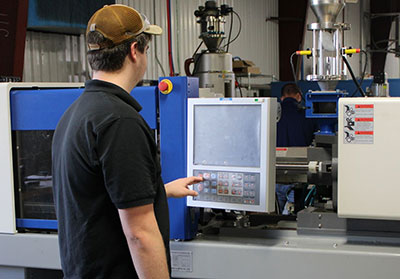
Dedicated dryers, closed-loop material handling and melt process controls yield consistent quality in molded devices. Controlled melting and blending: Once dried, the polymer pellets are fed into the barrel of the molding machine, where the material is melted and continuously fed toward the mold by a rotating mechanical screw. For polymers with additives and fillers, this phase mixes the formulation to achieve a homogeneous blend that results in uniform performance of the material throughout the finished part. At this stage, process temperatures and pressures must be tightly controlled to conditions specific to each plastic to avoid degrading the material.
-
Mold filling, part cooling and ejection: The melted polymer is injected into the mold under controlled conditions to minimize stress and fill the mold cavities to exact part dimensions. When the melt cools and solidifies to form the desired part, the mold opens, ejects finished components, and another cycle begins immediately.
The Materials Component: Benefits of Medical Thermoplastics Used in Devices
Medical plastics processed by injection molding are a select group of materials. Their basic characteristics include toughness and durability, rigidity, chemical resistance and retention of properties after repeated sterilization. Most notably they offer different levels of biocompatibility based on allowable times the medical device is in contact with internal bodily fluids and tissue.
Several medical plastics are compliant for contact for up to 24 hours, with PEEK, Radel® PPSU, polysulfone and certain grades Ultem® PEI as examples. Medium-term implantable plastics are cleared for use in devices that see internal contact for up to 29 days. Long-term implantable plastics are a highly specialized group. All are certified for use in devices that are implanted for 30 days or longer, including permanent implantation. This select field includes implantable PEEK, implantable PPSU and implantable polysulfone (PSU).
As a production process for implantable devices, injection molding lends itself to the rigorous quality standards required to process these medical polymers and is scalable as demand for components and devices increases.
Machining as a Complementary Process
Injection molding has been a primary manufacturing process for the medical device industry for decades. As quantity requirements increase, it is usually the next step up from precision machining of stock shapes, a production method commonly used for prototyping, design and material validation, and for low volume or introductory quantity requirements. Machining also can be a complementary process in that it is used to add details and design features to injection molded parts that cannot be achieved by the molding process alone or would be too costly to design into the tooling or process. In addition, specialized medical plastics machining companies are available with the equipment and quality management systems that comply with the strict standards required for implantable device production.
Medical Plastic Processing Expertise Optimizes Performance and Quality
Decades of rapid growth in medical plastics injection molding confirm its benefits as a primary production method for medical devices. Specialists invested in medical plastics melt processing can ensure that the quality and performance possible with the process are achieved.
A well-qualified injection molder has quality management systems encompassing material handling, drying, processing and packaging that satisfy or exceed industry regulatory standards. State-of-the-art all-electric molding machines ensure clean, consistent, fast and efficient production. Control systems including pressure transducers integrated in the melt stream and in the tooling are also beneficial. They maintain conditions that achieve the highest levels of performance and consistency in the polymer, and precise dimensional tolerances in finished parts.
Bottom line in this and many other high-technology industries: quality, consistency and efficiency are routinely achieved with best-in-class machines in the hands of an experienced practitioner.
